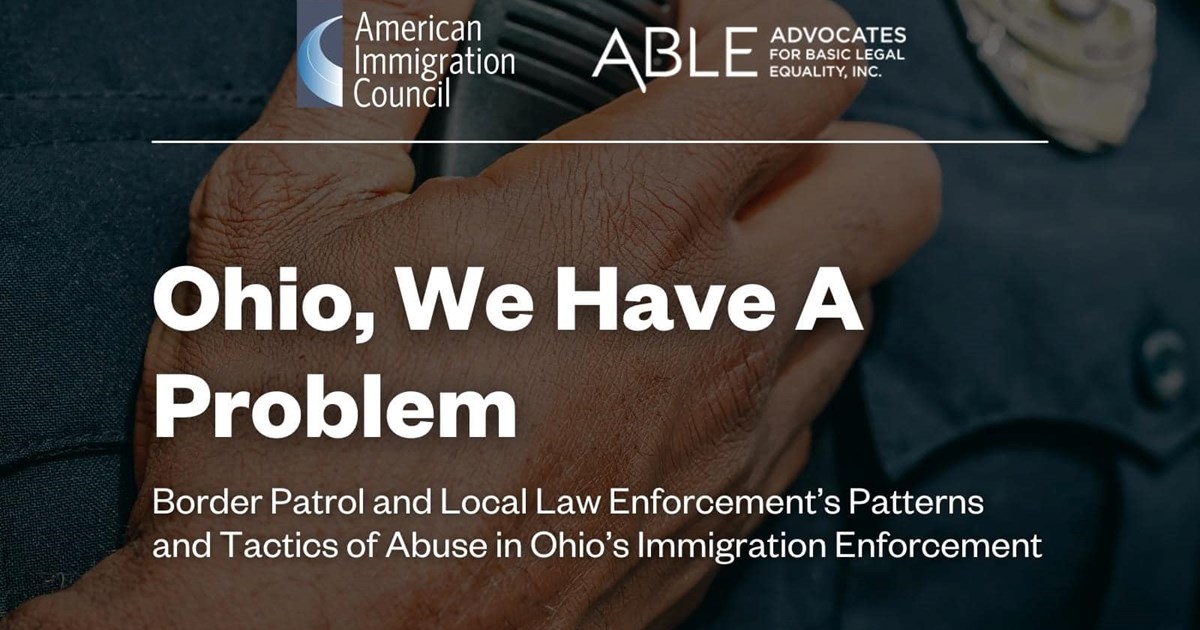Advocates for Basic Legal Equality, Inc. (ABLE) is a non-profit regional law firm that provides high quality legal assistance in civil matters to help eligible low-income individuals and groups in western Ohio achieve self reliance, and equal justice and economic opportunity.
Records Shed Light on Border Patrol’s Racial Profiling of Immigrants in Ohio

Newly analyzed government data exposes several concerning enforcement practices employed by U.S. Border Patrol (USBP) agents at the Sandusky Bay station to detain immigrants in northern Ohio. The information released today by the American Immigration Council confirms reports by local community organizations of widespread use of racial profiling and problematic apprehension practices by both Border Patrol and local law enforcement. The report follows an ongoing investigative project, which analyzed records obtained through the Freedom of Information Act (FOIA) and calls for greater transparency and oversight of Border Patrol’s enforcement activities near the nation’s northern border.
The data sheds light on the Border Patrol’s enforcement activities and its close collaboration with local law enforcement agencies. The findings reveal that Border Patrol agents from the Sandusky Bay station primarily targeted darker skinned Latino males classified as laborers between the ages of 23 and 40.
In March 2021, the Council and Advocates for Basic Legal Equality, Inc. (ABLE) filed FOIA requests asking for information about the Border Patrol’s immigration enforcement practices in Ohio. The requests focused on Border Patrol’s Sandusky Bay station near Port Clinton, Ohio. The organizations also filed several requests for state public records with the Ohio State Highway Patrol (OSHP).
“These findings suggest that Border Patrol agents used local law enforcement agencies to target Latinos who fit a certain profile for enforcement, detention, and removal,” said Raul Pinto, Deputy Legal Director for Transparency at the American Immigration Council. “The report underscores the importance of transparency and data collection to hold immigration enforcement agencies accountable and ensure meaningful oversight.”
“ABLE is proud to partner with the American Immigration Council in our joint FOIA litigation efforts and the creation of this report,” said Kathleen Kersh, Senior Attorney in ABLE’s Agricultural Worker and Immigrant Rights practice group. “For over fifteen years, our Latinx and farmworker client communities have been targeted by Ohio’s local law enforcement and Border Patrol’s unjust collaboration. The data in this report show what our clients have always known: this collusion unfairly targets Latinx individuals and people of color. Thousands of miles away from the southern border, we see families separated and individuals discriminately fast-tracked through the deportation pipeline.”
In January 2022, the Council and ABLE filed a lawsuit to compel the government to respond to the organizations’ FOIA requests.
The subsequent report analyzes a systematic sample of Form I-213 Record of Deportable/Inadmissible Alien – a document similar to an arrest report, Border Patrol’s Apprehension Log, and Ohio state records to better understand patterns in enforcement actions along the U.S.-Canada border and share the findings with the public.
The analysis of Border Patrol’s enforcement data reveals several crucial takeaways:
- Primary targets of immigration enforcement were males, classified as laborers of Latin American origin between the ages of 23 and 40, deemed to have darker skin.
- More than half of the arrests noted in the I-213s sample were initiated by Ohio local law enforcement.
- Sixty-nine percent of all I-213s in the sample had no noted criminal history.
- Ohio law enforcement officers frequently requested that USBP agents assist them with identification checks even though the vehicle occupants had valid identification.
To access the detailed data and analysis, click here.
Read the report in Spanish here.
